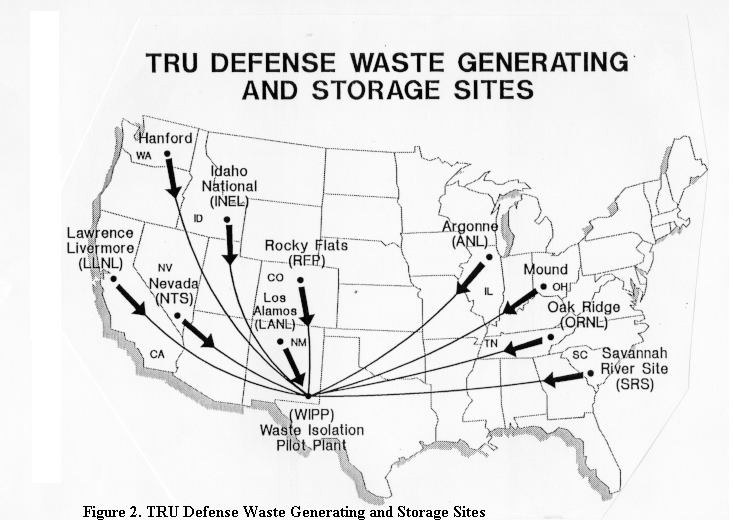I have often blogged about the problems at the Waste Isolation Pilot Plant near Carlsbad, New Mexico because it is the only functioning permanent geological repository for nuclear waste operating in the United States. It is primarily intended to accept transuranic wastes from U.S. nuclear weapons laboratories and production facilities. It does not accept spent nuclear fuel.
An accidental release of radioactive particles of plutonium and americium occured last February because one of the storage drums in the salt mine repository burst open. Some sort of chemical reaction raised the temperature of the contents of a drum and ruptured it, ejecting radioactive white foam. The mass of foam went into the ventilation system. Twenty one workers were exposed to radioactive contamination as a result. The ventilation safety system was not up to standards and the response to the emergency was not fast enough. This allowed release of the radioactive isotopes into the outside environment. The drum that burst was one of a batch shipped from the Los Alamos National Laboratory. It is now six month later and it is still unclear exactly what caused the drum to burst.
Although the handling process for nuclear waste at the WIPP is supposed to include thorough documentation and prior approval of every substance put into one of the waste drums, this did not happen in the case of the ruptured drum. Without knowing exactly what was in the drum, the Energy Department has been trying to duplicate the exothermal reaction in the lab with a variety of materials that might have been in the drum. So far, the attempt to reproduce the reaction has failed.
A preliminary report from the Energy Department's investigation found that the WIPP "does not have an effective nuclear safety program." The investigators found over thirty safety violations. The report said that "degradation of key safety management programs and safety culture resulted in the release of radioactive material from the underground to the environment."
The laboratories that are currently holding nuclear waste slated for delivery to the WIPP were under orders to clear out all their nuclear waste in the near future. Now that the WIPP is closed, this waste is piling up at the facilities or being sent to temporary storage. Without knowing exactly what caused one drum from LANL to burst, it is possible that other such drums at LANL, the WIPP or temporary storage in Texas may burst as well. The closing of the WIPP is impacting activities at labs and facilities. The Idaho National Laboratory is considering building a warehouse for temporary storage of their waste. The cleanup of the Hanford Nuclear Reservation in Washington State will be slowed down because they are unable to ship out almost nine thousand drums of waste to the WIPP.
Future plans for the WIPP repository include the delivery of more highly radioactive waste from laboratories and production facilities. This accident will close WIPP for at least eighteen months and may close it permanently. The cost of the accident is estimated at over a billion dollars.
The U.S. does not have a permanent geological repository for spent nuclear fuel which is piling up at nuclear power reactors around the country. The situation at the WIPP raised concerns about the Energy Department's ability to construct and safely operate such a facility in the future.
